After ranking the top-20 centres, right wingers, and left wingers, and the first 20 defencemen in our top 40 in the NHL over the past three seasons, we’re moving on to ranking the top 20 defencemen relative to their peers today. You can check out 2016’s top 20 here, and 2017’s list here.
Like the previous two years, I owe a lot of thanks for this project to others in the hockey analytics field, such as Emmanuel Perry, Dom Luszczyszyn, Steve Burtch, Dominic Galamini Jr., and Tyler Dellow. Their help along the way directly and indirectly influenced this project.
Statistics for this project were collected from SPORTLOGiQ, Natural Stat Trick, Corsica, Puck IQ, Hockey Reference, the NHL’s official website, and Dom Luszczyszyn’s Game Score database.
[snippet id=4234155]
In order to get a larger sample size to work with, this year I lowered the barrier of eligibility for the rankings from 2000 5-on-5 minutes over three seasons to 2000 minutes overall. This helped include some promising young players, but there are still rookies from last year who won’t make the cut — 193 defencemen qualified for the project.
The weighting of the categories for defencemen remains the same as last season: 25 for offence, 40 for transition and 35 for defence, though there are new statistics added and the difficulty of minutes adjustment has been changed.
Previously, players could be awarded a maximum of a 25 per cent boost to their score based on the difficulty of their minutes, while this year that category was boosted to 30 per cent. The mean score for each position was taken and deducted from each individual’s difficulty score, so a player’s score could be boosted or knocked down depending on the difficulty of the minutes they were assigned. The difficulty adjustment is already applied to the numbers shown and on the graphics.
Each season was weighted so that recent years account for more of a player’s total score, with 22.2 per cent for 2015-16, 33.3 per cent for 2016-17, and 44.5 per cent for 2017-18. If a player only played in two of those years they would see a weighting of 42.8 per cent for 2016-17, and 57.8 per cent for 2017-18.
[relatedlinks]
Here are the statistics used in each category:
Offence: 5-on-5 and power play goals, primary assists, secondary assists, high danger scoring chances, scoring chances, passes to the slot, scoring chances off the rush, passes off the rush, offensive zone passes, rebound recoveries, scoring chance generating plays, shot attempts, penalties drawn, on-ice goals for relative to teammates (all per 60 minutes), and offensive zone pass completion rate.
Transition: 5-on-5 outlet passes, stretch passes, controlled carries out of the defensive zone, neutral zone passes forward and east-west, controlled entries into the offensive zone (all per 60 minutes), Corsi for percentage, Corsi for percentage relative to teammates, controlled exit rate relative to teammates, controlled entry rate relative to teammates, outlet, stretch, and neutral zone pass completion rates relative to teammates.
Defence: 5-on-5 and shorthanded loose puck recoveries by zone, defensive zone non-dump in loose puck recoveries, blocked passes, stick checks, body checks, blocked shots, puck battles won, puck battles won percentage, controlled entries against, odd-man rushes against, total zone clearances, penalties taken, on-ice goals against relative to teammates, on-ice shot attempts against relative to teammates, on-ice passes to the slot against relative to teammates, on-ice high danger chances against relative to teammates (all per 60 minutes), turnover rate by zone relative to teammates.
Degree of difficulty: Puck IQ’s competition faced percentages (2016-17 only), Game Score’s quality of forwards faced, Game Score’s quality of defencemen faced, Game Score’s quality of teammate forwards, Game Score’s quality of teammate defencemen, Corsi quality of competition, Corsi quality of teammates, time on ice quality of competition, time on ice quality of teammates, personal shooting percentage relative to career average, on-ice shooting percentage, on-ice save percentage, defensive zone starts percentage, 5-on-5 ice time, and overall ice time per game.
There’s a slight change to the charts this year as well, as I’ll be showing how players rank both in percentile form — a straight up ‘what percentage of their peers are they ahead of” — and also the percentage that the player impacts a category compared to the best player at their position, which I’m calling per cent of peak. For example Josh Manson’s offensive impact is 44.5 per cent of Brent Burns’.
Let’s get into it.
20. Colton Parayko
Difficulty adjustment: +3.16%
Offence: 13.05/25 | Transition: 25.71/40 | Defence: 20.12/35
Total: 58.89/100
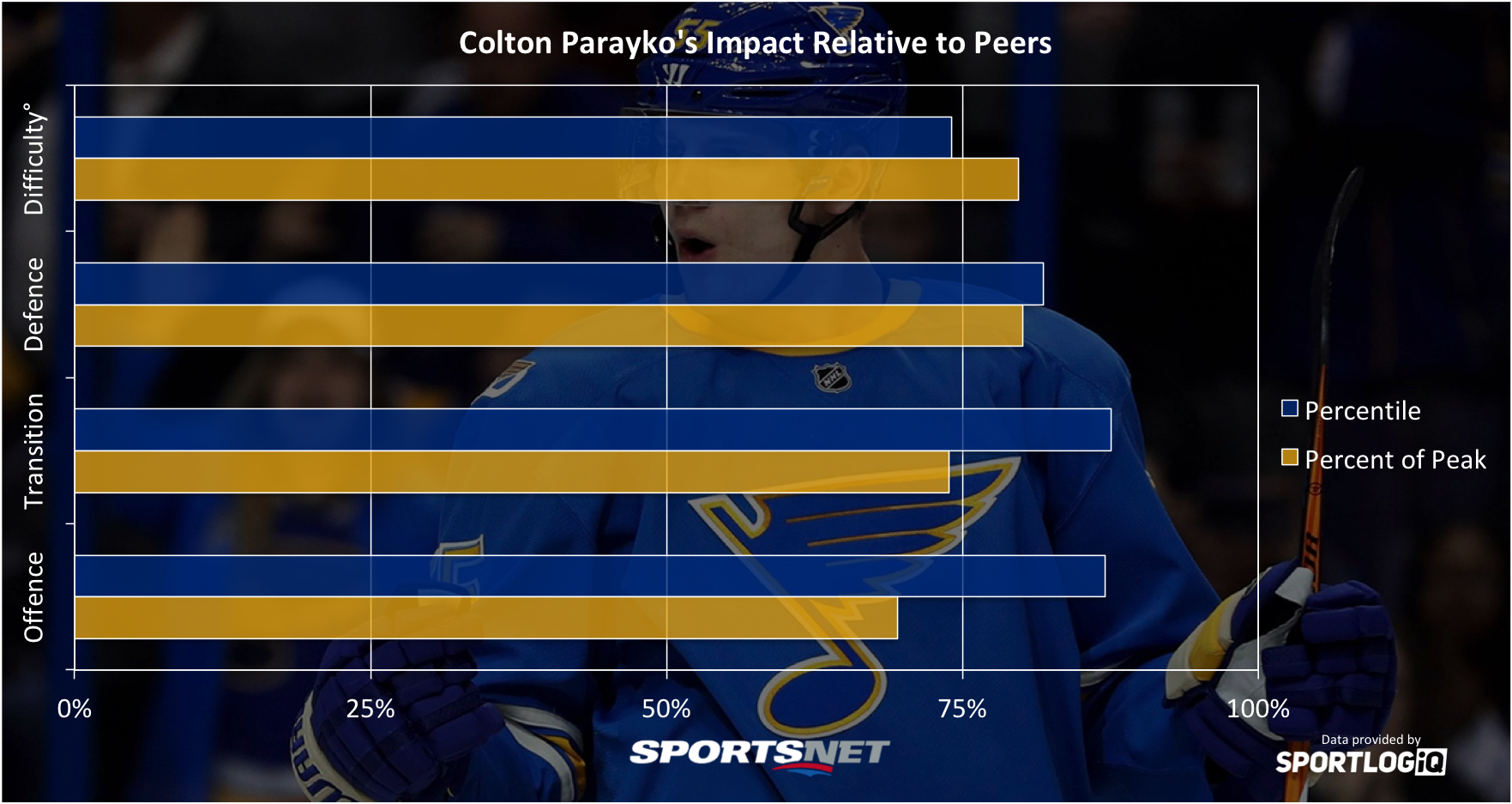
Last season I speculated Parayko’s tough year in transition play may have been a sophomore slump and we’d see improvement in year three. As it happens, he was a top-10 defenceman in transition play last season, behind only the elite players at his position. Parayko is a big boy at 6-foot-6, but he’s also a heck of a skater, and his ability to exit the defensive zone with possession separates him from his peers in transition. Only a handful of players in the league were as involved in their team’s transition game.
Defensively, Parayako is a puck retrieval monster and a voracious puck battler, not to mention an aggressive defender one-on-one. He’s also very strong in the neutral zone, cutting down controlled entries and scoring chances off the rush. He’s remarkably disciplined, an area where he saw huge improvement last season. If he can post a shooting percentage as high as his rookie year to go along with these improvements he’s made to his game, Parayko could fly as high as being a Norris candidate.
19. Tyson Barrie
Difficulty adjustment: +4.90%
Offence: 16.69/25 | Transition: 25.93/40 | Defence: 16.70/35
Total: 59.32/100
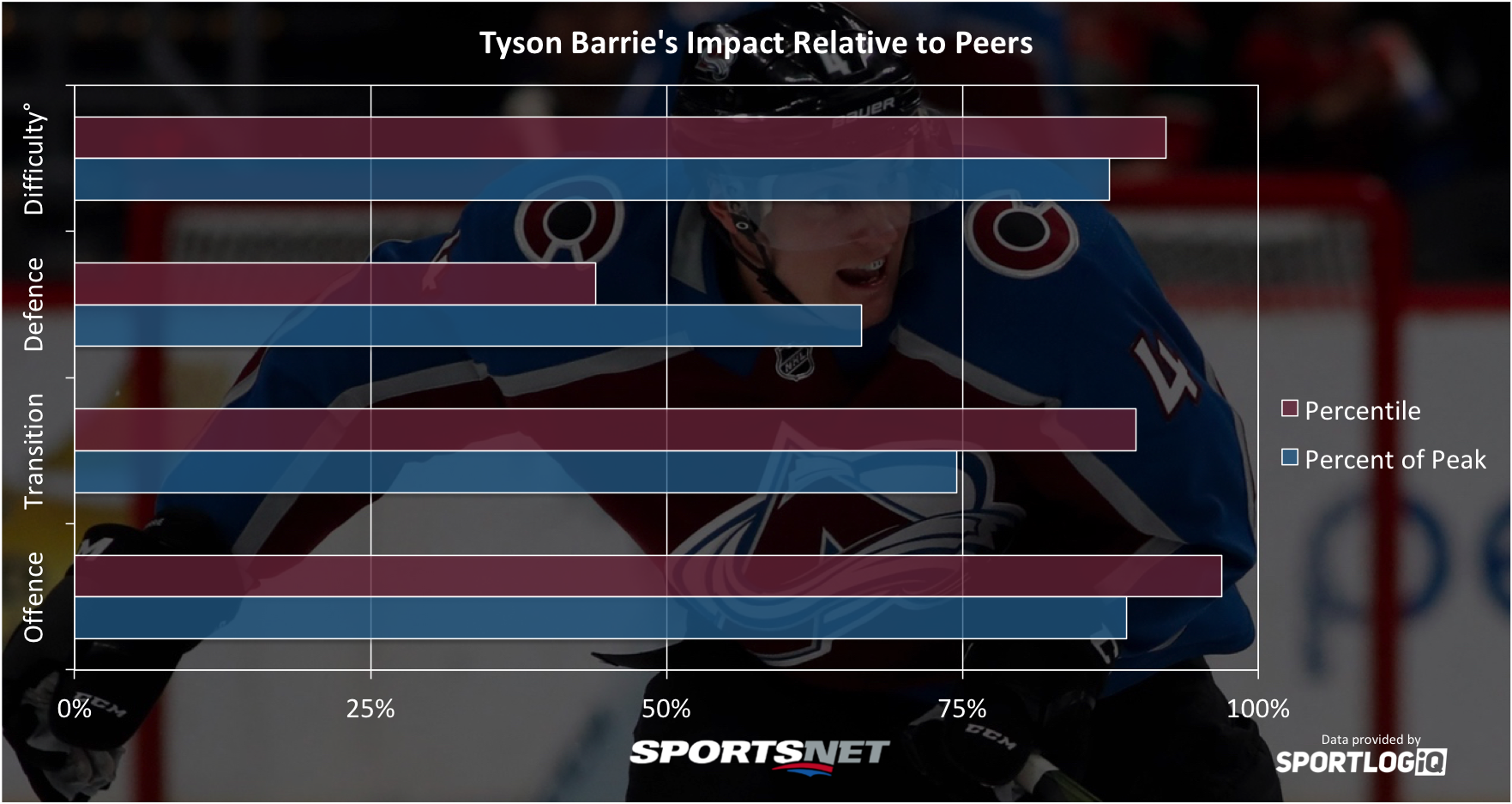
If the Colorado Avalanche were going to rebound from their historically bad season in 2016-17, you had to think Tyson Barrie was going to need to find the offence he lost that year – and he sure did. Barrie was absolutely dynamic in 2017-18, notching the second-highest offensive impact of any defenceman last season, which was built around his playmaking. He was a primary assist machine for the Avalanche at even strength and on the power play, a perfect complement to Nathan MacKinnon’s rushing style.
In transition, Barrie has been virtually the same player each of the past five seasons. He’s great at carrying the puck up ice and rarely resorts to dumping the puck out, but he can get into trouble by making defensive zone passes that are too dangerous. He doesn’t make as many mistakes overall in the neutral zone, though, and is a nice boost to his team’s attack.
18. Hampus Lindholm
Difficulty adjustment: +2.46%
Offence: 11.14/25 | Transition: 27.27/40 | Defence: 21.07/35
Total: 59.48/100
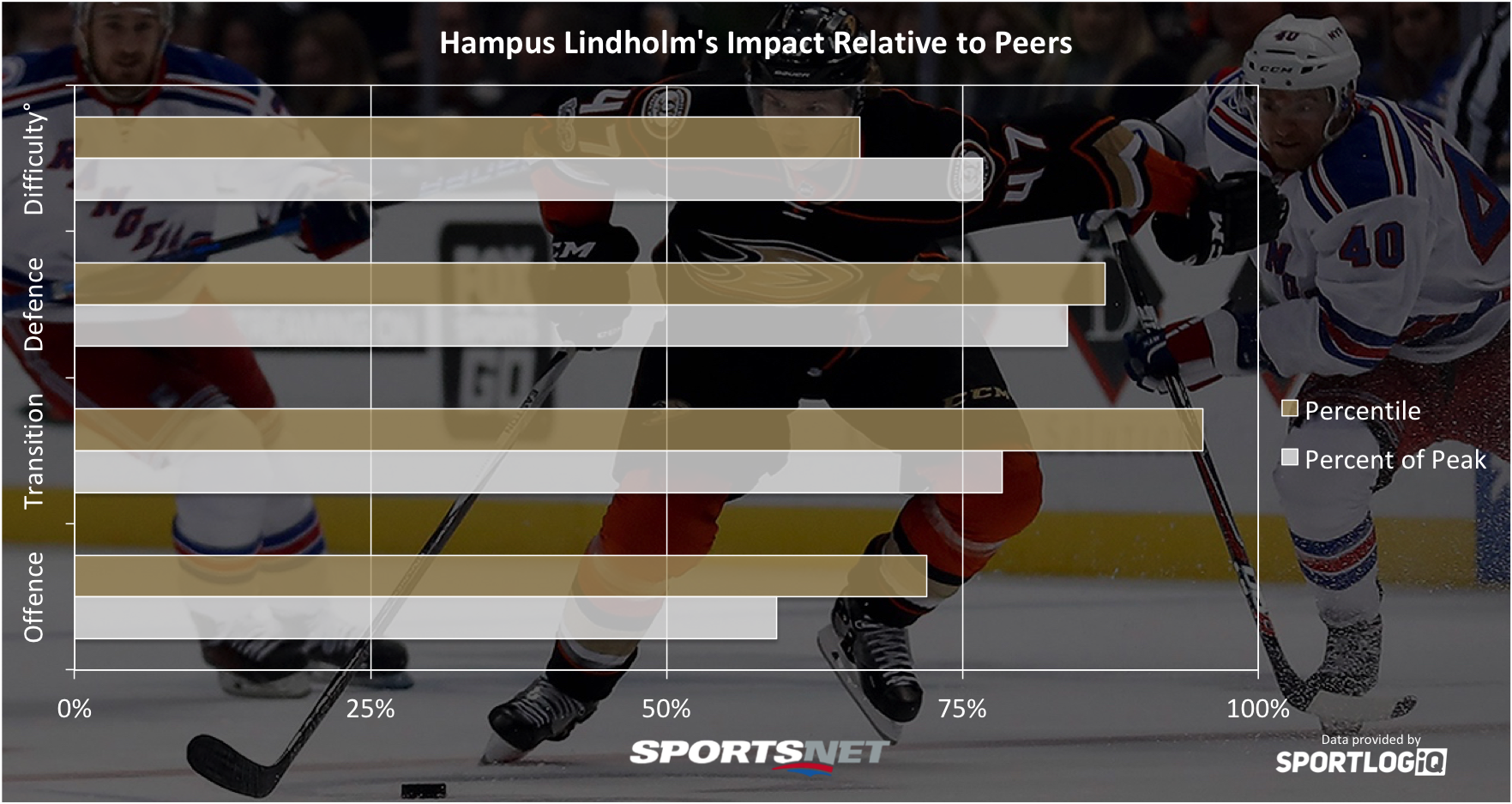
One of the toughest players to play against in the league because he’s so smart, Lindholm is an excellent shutdown defenceman who specializes in winning puck battles, blocking passes, and cutting players off in the neutral zone. Only a couple players in the league allow fewer controlled entries.
Lindholm doesn’t directly bring a lot of offence to the table, but his ability to move the puck up the ice provides far more and better chances for his teammates than you might expect by just looking at his point totals. Lindholm is heavily involved in directing neutral zone traffic and makes passes to open up lanes for teammates to attack more off the rush. He’s an incredibly important cog in the machine for an Anaheim team that struggles to play with pace.
17. Dustin Byfuglien
Difficulty adjustment: +4.70%
Offence: 14.72/25 | Transition: 21.94/40 | Defence: 23.10/35
Total: 59.76/100

I am in awe of this lad and you should be, too. Byfuglien is a strange defenceman for the modern game — he excels at both ends of the ice, but struggles a little bit in the middle. Byfuglien doesn’t like to carry the puck much, and doesn’t get many touches at all in the neutral zone, but he does make up for it in the other two zones.
Defensively, Byfuglien is the NHL’s reigning champion in puck battles. Any puck battle between two players can end in a win, loss, or draw (where neither player gains possession or a third player jumps in and wins it). The league average win rate for defencemen is 38.5 per cent and a good puck battler will win about 40 per cent of the time.
Byfuglien, though, wins 50.3 per cent of the puck battles — he’s. Add in his strong neutral zone defence that cuts down controlled entries and you have a player who is really hard to generate offence against. Attack the blue line and odds are he stops you. Dump it past him and you have to deal with him physically on the boards. Good luck with that.
[snippet ID=3322139]
16. Zach Werenski
Difficulty adjustment: -0.62%
Offence: 16.61/25 | Transition: 27.32/40 | Defence: 14.27/35
Total: 60.20/100
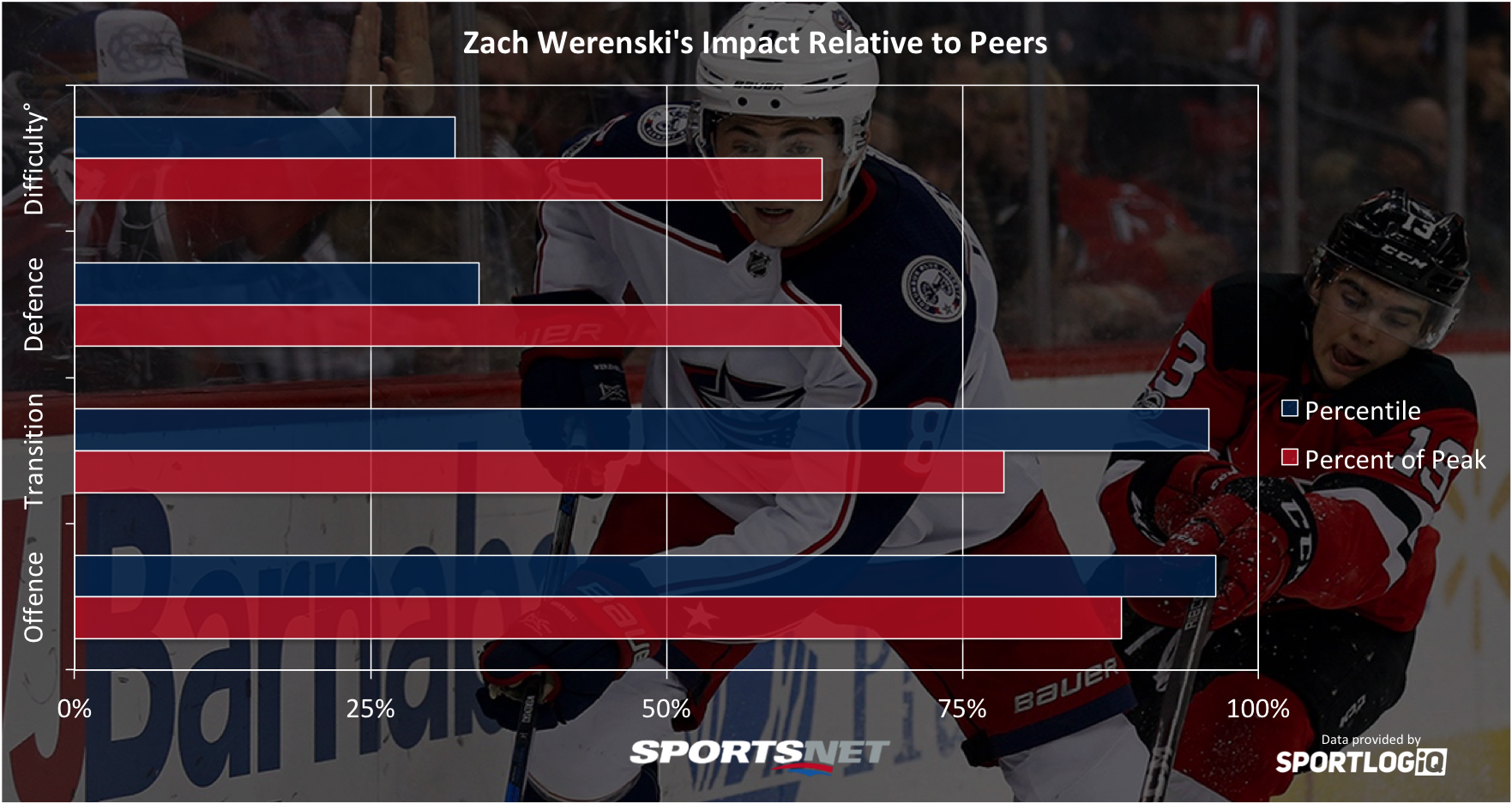
After a bonkers rookie season that should have ended in a Norris Trophy nomination, Werenski took a slight step back in 2017-18 offensively and defensively. Still, he remains one of the NHL’s top defencemen. His playmaking took a hit last season, but Werenski seems like a special goal scorer from the back end, able to convert on aggressive pinches without leaning too much on power play production.
His transition game is built more around rushing the puck himself than passing it, and he happens to be one of the NHL’s most efficient zone exit players among defencemen. He could probably use some variability in his game when moving the puck, but remember he’s just 21.
15. Duncan Keith
Difficulty adjustment: +3.70%
Offence: 10.41/25 | Transition: 28.28/40 | Defence: 21.59/35
Total: 60.27/100
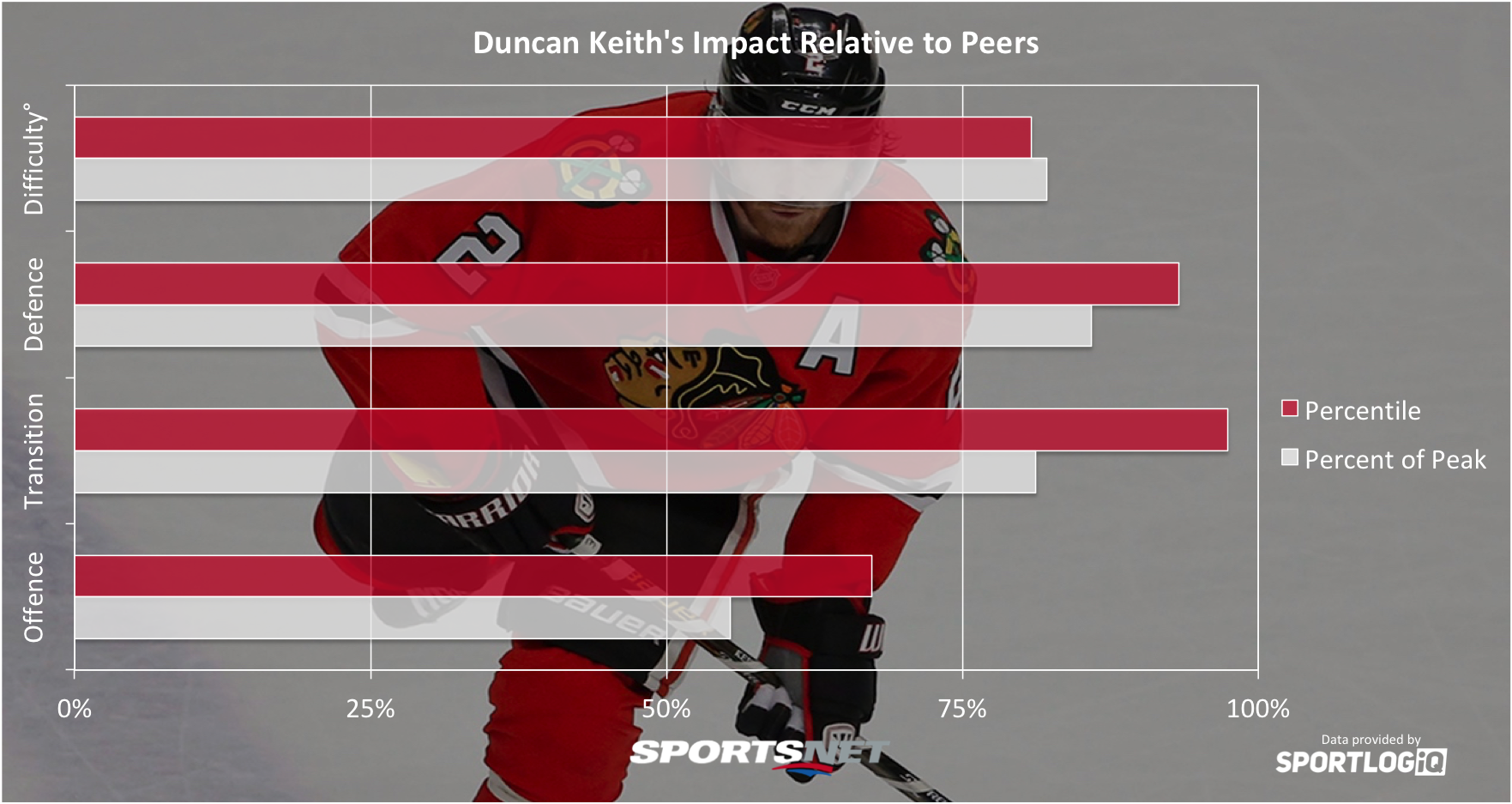
Duncan Keith had a rotten season last year with huge drop offs in offensive and defensive impact. But after breaking down the numbers I found that his season looked a lot worse on the surface that it actually was. By no means was Keith at peak performance, but he remained one of the NHL’s premier puck mover. A combination of absurdly bad luck and his specific struggles of repeatedly being exploited made him look like he was finished.
The prime years for Keith are gone, but I don’t believe he is finished yet. He’s still the top combined neutral zone and defensive zone passer at his position when you account for both volume and success rate and that launches the Blackhawks’ transition game, which is still their strength. Keith is smart at both blue lines — he rarely commits turnovers, constantly recovers loose pucks, is an above average puck battler, and rarely takes penalties. I could be wrong and he could be even worse this season because age is a killer, but I think there’s some kind of rebound coming.
14. Kris Letang
Difficulty adjustment: +4.08%
Offence: 13.83/25 | Transition: 25.30/40 | Defence: 21.32/35
Total: 60.45/100
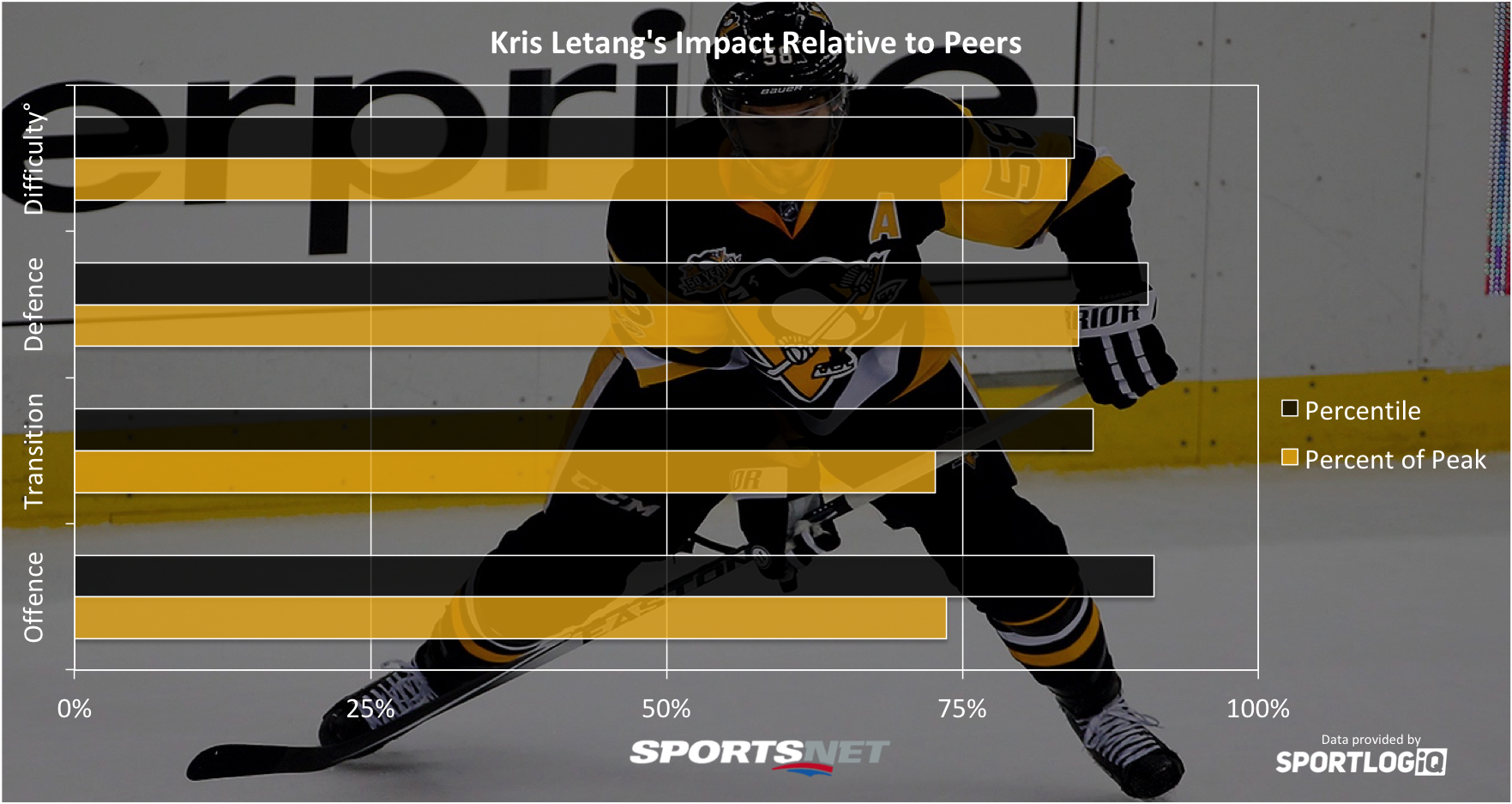
We’ll probably never know how great of a career Kris Letang would have had if not for the ridiculous string of injuries and illnesses he’s suffered, but even with those he’s been a phenomenal player. Letang has the reputation of being bad on defence, but he’s an excellent puck retriever, one of the league’s most impressive and deceptive puck battlers, and a top-end penalty killer. The main knock is that he can get a little turnover happy in the defensive zone.
A balanced player, Letang ranks among the top-31 defencemen in each category, meaning he’s a No. 1 defenceman no matter how you slice it. His weakest area is actually in transition, mostly due to a low success rate on defensive zone passes.
[snippet id=3816507]
13. Jeff Petry
Difficulty adjustment: +4.25%
Offence: 12.86/25 | Transition: 25.95/40 | Defence: 21.70/35
Total: 60.51/100
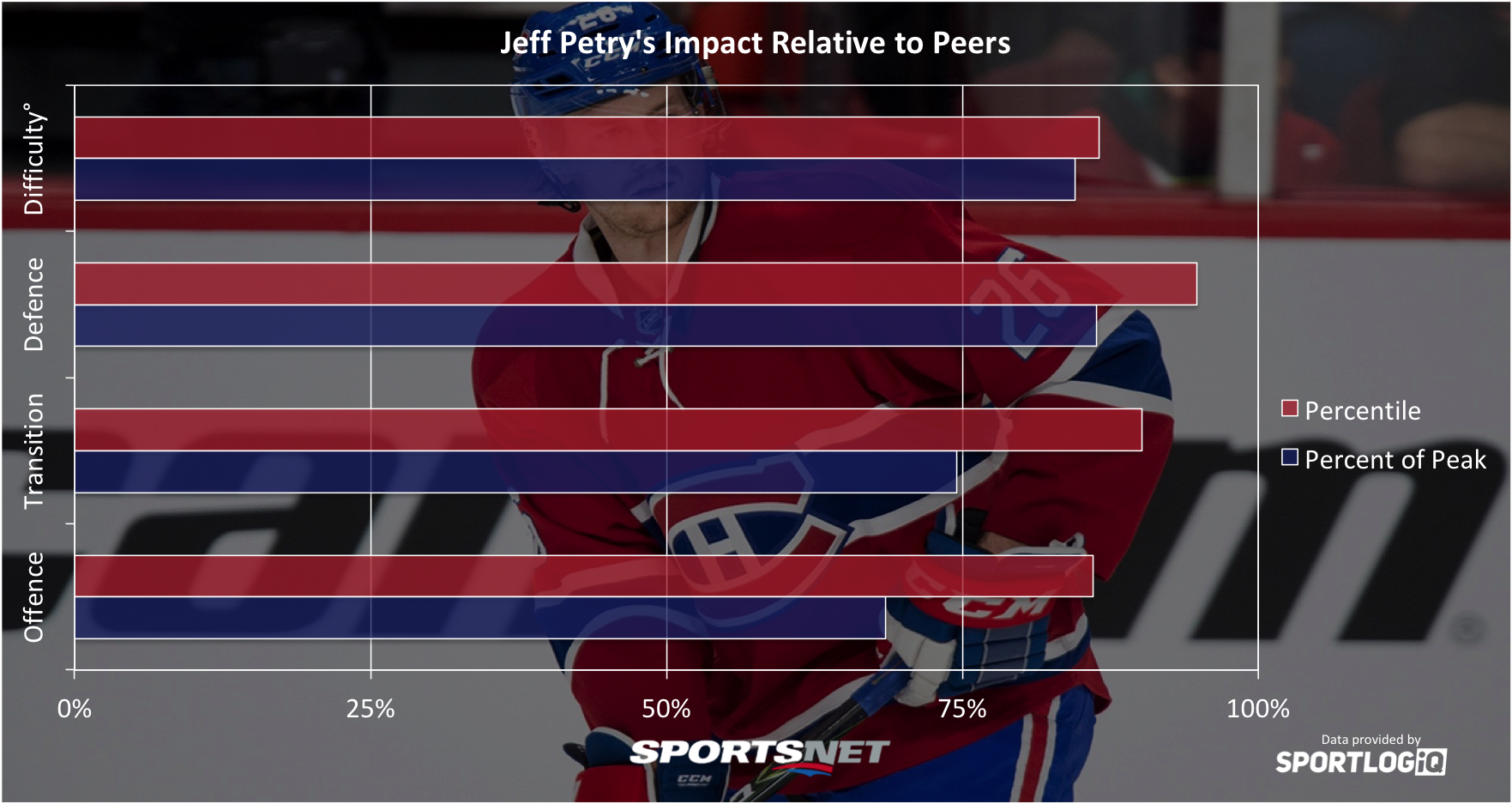
A monster season on the power play boosts Petry’s offence in a huge way, while consistently excellent play in transition and without the puck vaults him 10 spots up the rankings from last season.
A great example of why you shouldn’t pay attention to plus/minus, Petry played brutal, thankless minutes with one of the worst partners in the league last season on a terrible team. Scoring chances and shots against go down while Petry’s on the ice despite facing top lines, thanks in part to his ability to strip opponents of the puck with stick and body checks, and win puck battles.
Petry is also a strong neutral zone defender. When he forces dump-ins it’s to his advantage because of his excellent skating and he ends up recovering a lot of loose pucks. If Petry does have a defensive weakness, it’s in blocking passes, and unfortunately that was a team-wide weakness for the Canadiens last season.
12. Victor Hedman
Difficulty adjustment: +2.01%
Offence: 16.77/25 | Transition: 23.01/40 | Defence: 21.19/35
Total: 60.97/100

Okay, this one is going to be controversial so it’s a bit of a longer write-up. I can’t get into the heads of voters, but just reading the media landscape last season about 20 games in, it seemed the decision had already been made that it was Victor Hedman’s ‘turn’ to win the Norris. Here’s the thing, though: he wasn’t very good last season, and that’s especially true when you compare him to himself in previous years.
Hedman saw declines in his game across the board in 2017-18, feasting on the Lightning’s team-generated offence despite being less involved in those offensive plays than any of the previous four years. He was still arguably the top power play defenceman in the league, but that play didn’t translate into goals as often as it had in the past.
Transition has always been Hedman’s weakest area, and last season was no exception. He had one of the lowest defensive zone pass success rates relative to his teammates in the entire NHL, and one of the highest turnover rates, leading to a lot of regrouping and panic defending.
Defensively Hedman is still one of the most aggressive players in the league, and he strips possession from opponents more often than almost anyone. But he struggled in puck battles compared to recent years, and his shot suppression left a lot to be desired.
Overall Hedman still performed like a top-pairing defenceman last season and he’s still an all-world player, but he should not have even been nominated for the Norris. Hopefully this routine of giving out the NHL’s top defenceman award as a lifetime achievement ends in 2019.
11. Alex Pietrangelo
Difficulty adjustment: +4.94%
Offence: 13.96/25 | Transition: 26.13/40 | Defence: 20.95/35
Total: 61.04/100
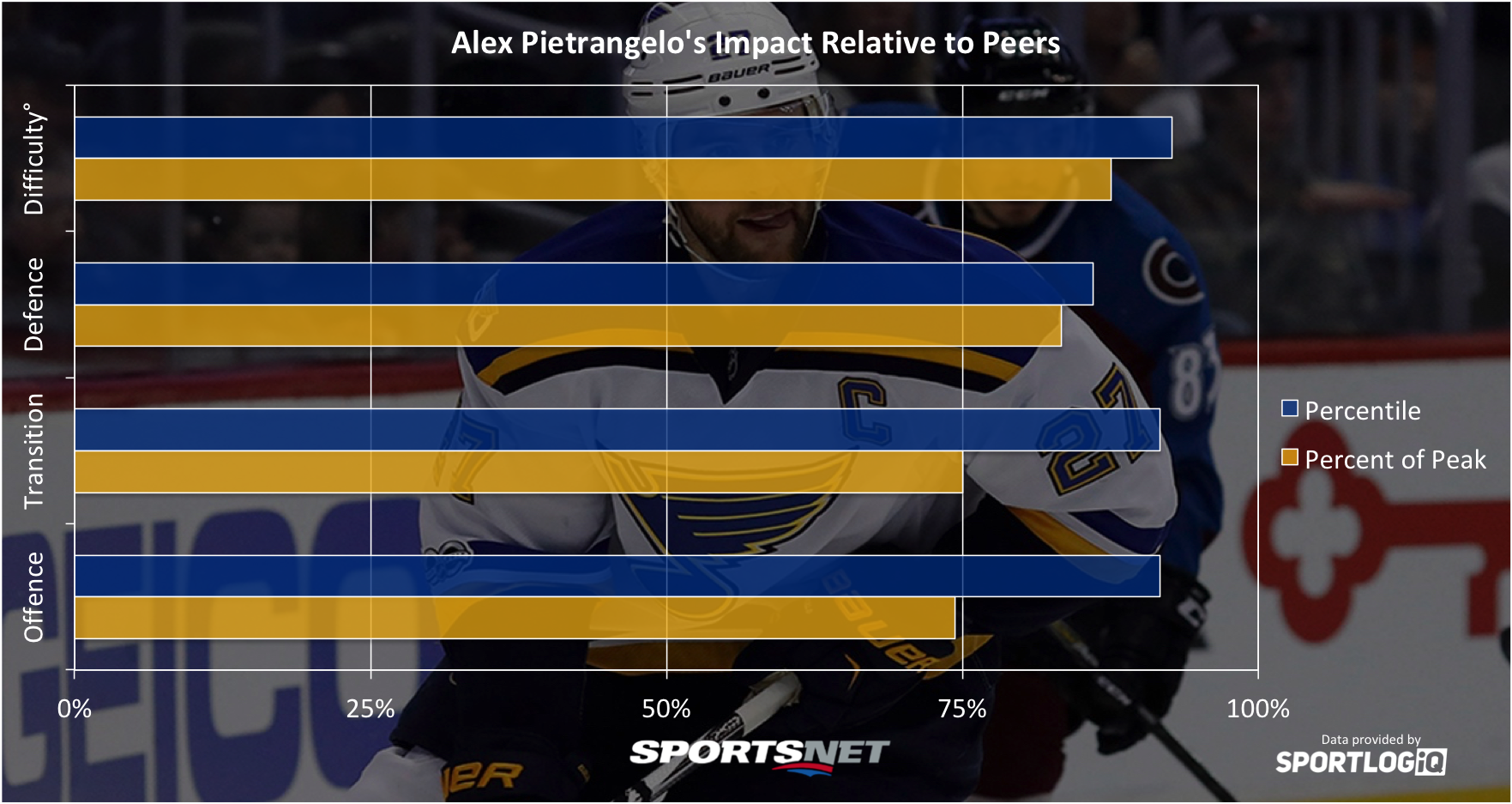
Consistently strong in each area of the game, Pietrangelo is always heavily involved in his team’s offensive game. He’s a big part of the cycle and keeping plays in the right places with incisive passes, and is a strong goal scorer when he’s given a little room.
Pietrangelo also creates a ton of the Blues’ offence indirectly by moving the puck up the ice more efficiently than almost any other defender in the league. He makes tons of tape to tape passes and skates the puck more effectively than most forwards. He combines that puck-rushing skill with low turnover rates in every zone, which makes him tough to exploit at 5-on-5. Weirdly, while Pietrangelo is arguably a top-five even strength defenceman, he’s really bad on special teams, especially the penalty kill. I’m not sure why that is, but his results have been awful there for years.
10. Oliver Ekman-Larsson
Difficulty adjustment: +7.40%
Offence: 14.25/25 | Transition: 24.40/40 | Defence: 22.58/35
Total: 61.24/100
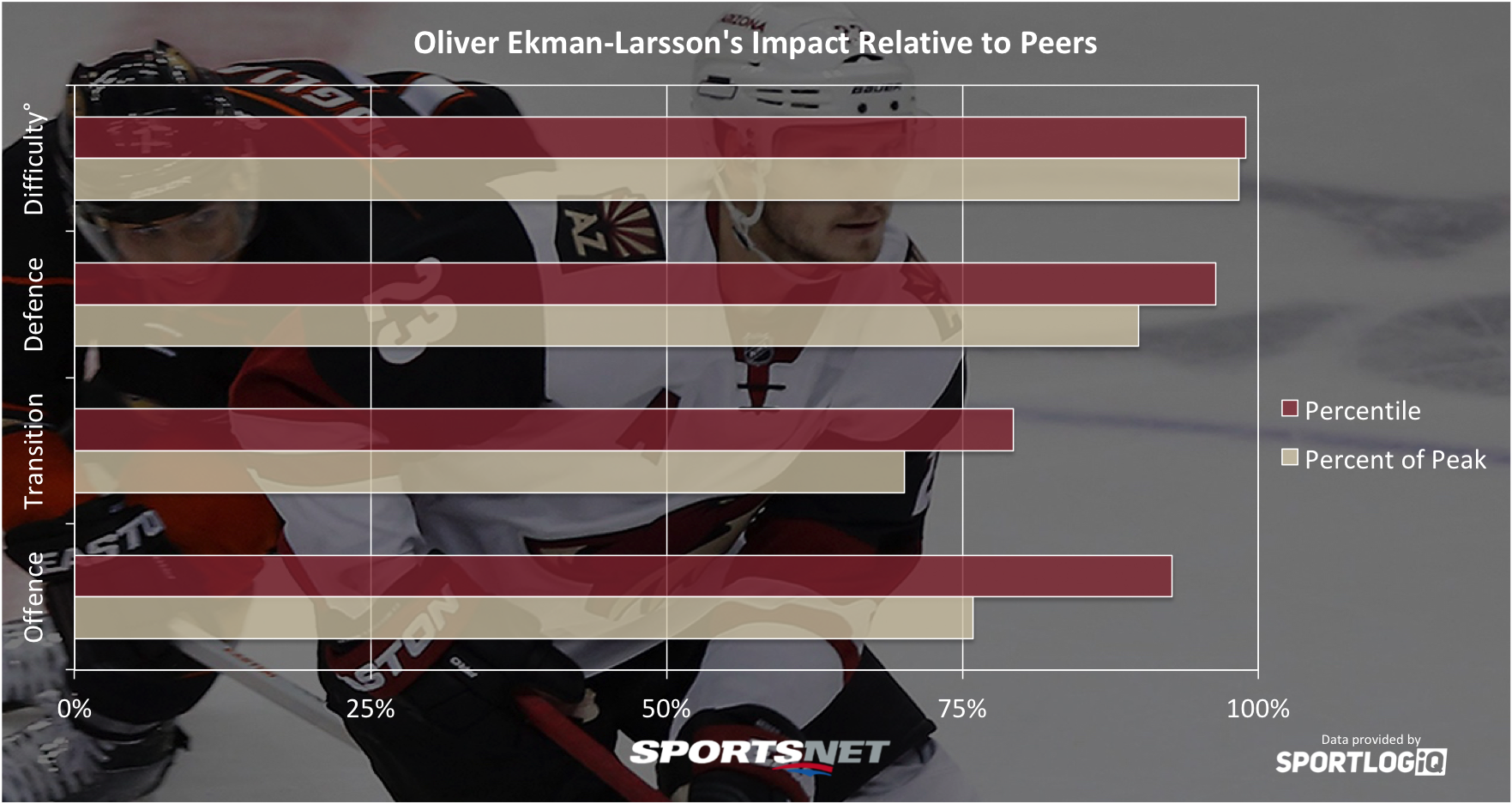
Before last season I was a bit skeptical of Ekman-Larsson as an elite level defenceman, but he was phenomenal in 2017-18 and posted massively improved numbers in each category. Ekman-Larsson is a one-man zone exit machine for the Coyotes who skates the puck out of danger under a lot of pressure for a team that isn’t great in its own zone, to put it mildly.
He’s a hound on loose pucks in the defensive zone, an excellent pass blocker, and one of the league’s best defenders of the blue line. When you combine that with his penalty-killing it makes him one of the game’s best shutdown defenders. One area he can get into trouble, though, is with defensive zone passes, where he carries a low success and high turnover rate.
9. Roman Josi
Difficulty adjustment: +1.61%
Offence: 18.00/25 | Transition: 27.44/40 | Defence: 15.83/35
Total: 61.27/100
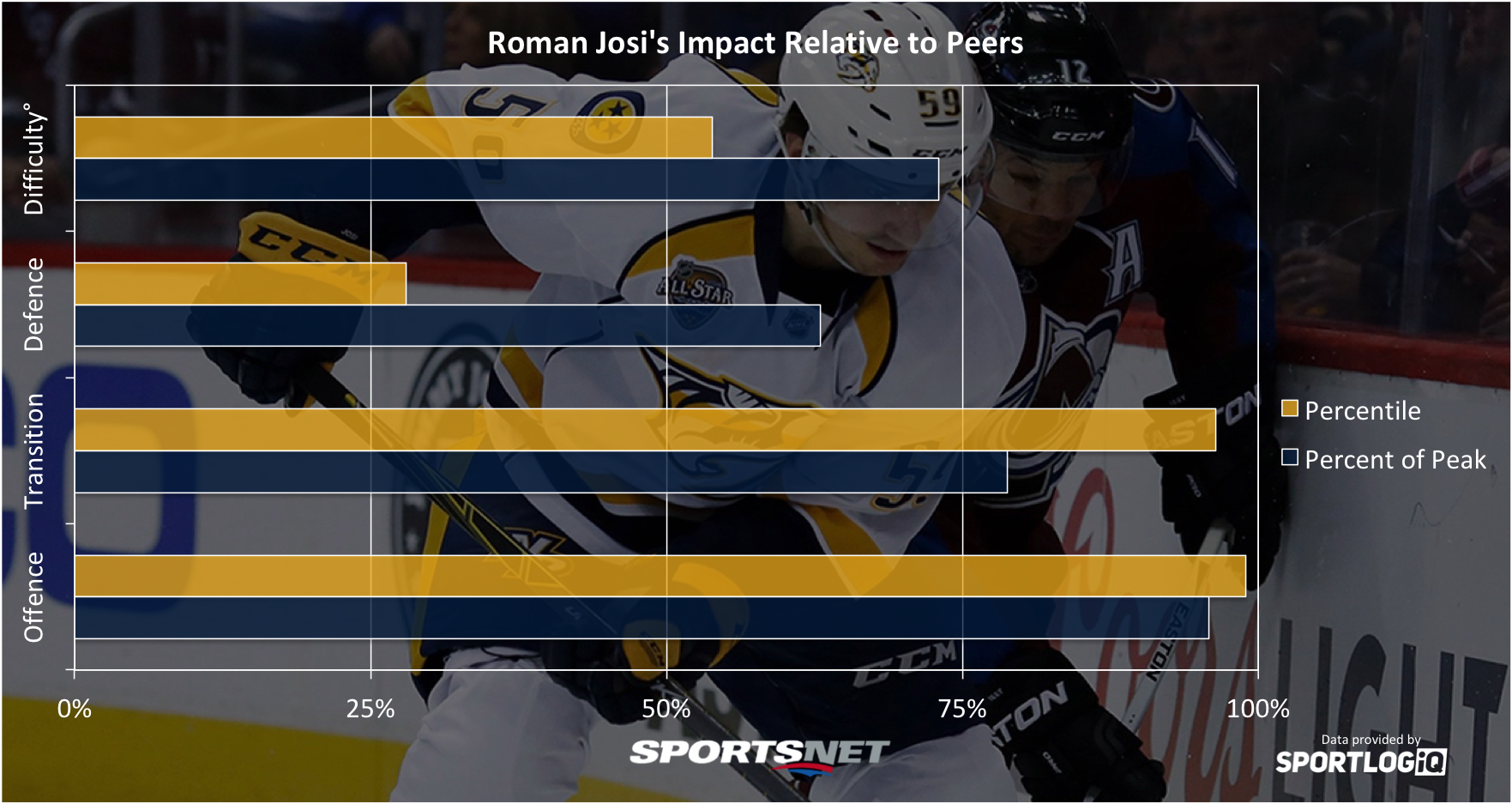
No defenceman in the NHL creates more scoring chances for his teammates than Roman Josi, who is the truest modern comparable to the rover position from way back in hockey history. Josi is a dominant offensive presence and is one of the few defencemen with the ability to not only set up scoring chances for teammates, but to regularly shoot from the slot at even strength.
His skating ability also makes him one of the most dynamic transition players in the game, but the overconfidence that comes with it is often what gets Josi into trouble on the defensive side. He can be guilty of being too hesitant with his gaps and not engaging enough without the puck, leading to extended time in the defensive zone and more goals against. But on balance, he remains a top impact player.
8. Seth Jones
Difficulty adjustment: +2.48%
Offence: 13.43/25 | Transition: 27.14/40 | Defence: 21.30/35
Total: 61.88

With two straight breakout years offensively, Jones continues to inch himself closer and closer to the Norris Trophy. He was solidly in the conversation last year, but finished just shy of a nomination, getting more attention for nearly doubling his offensive involvement while not seeing a drop in the other areas of his game.
Jones is an aggressive defender who isn’t shy about using his stick or body to remove possession from opponents, and his in-zone defence is really strong. If he has an area to improve on, it would be cutting down the turnovers because he makes a lot of those, and his neutral zone defence at the blue line could be a bit better.
7. Brent Burns
Difficulty adjustment: +1.68%
Offence: 18.78/25 | Transition: 22.22/40 | Defence: 21.60/35
Total: 62.60/100
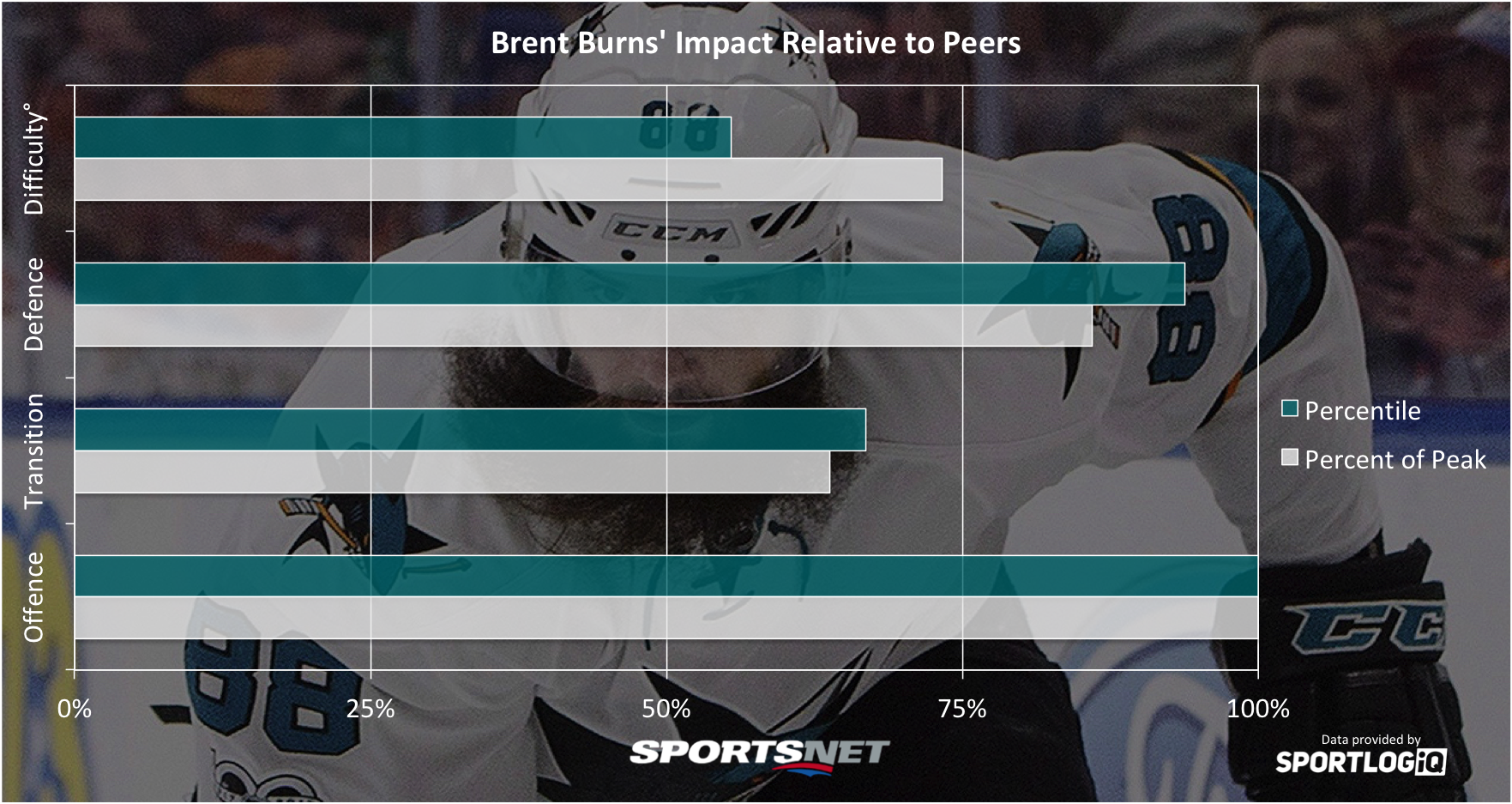
Brent Burns is weird. I’m not talking about his hair, or his facial hair, or the fact that he lives on some sort of snake farm or something. I’m talking about how he plays hockey.
Burns is an M134 Minigun from the blue line, ripping shots like there’s nothing he enjoys more in the world. He’s also an extremely skilled playmaker who isn’t afraid to just abandon his position and act like a forward for a shift. He can tilt the ice all on his own.
Defensively he’s nearly as good and constantly rips the puck away from opponents, wins battles, recovers loose pucks, and denies zone entries at rates most defencemen can’t compare to. Give him the puck outside the offensive zone, and you’re in for trouble. Burns has the single worst defensive zone pass success rate relative to teammates in the league, and commits a truly jarring number of turnovers in each zone. Clearly some of that is because he makes plays that are low percentage but high leverage, and there’s an argument it’s worth it, but it can bite back hard when things go wrong, which it did last season.
6. Cam Fowler
Difficulty adjustment: +3.08%
Offence: 11.69/25 | Transition: 28.98/40 | Defence: 22.05/35
Total: 62.72/100
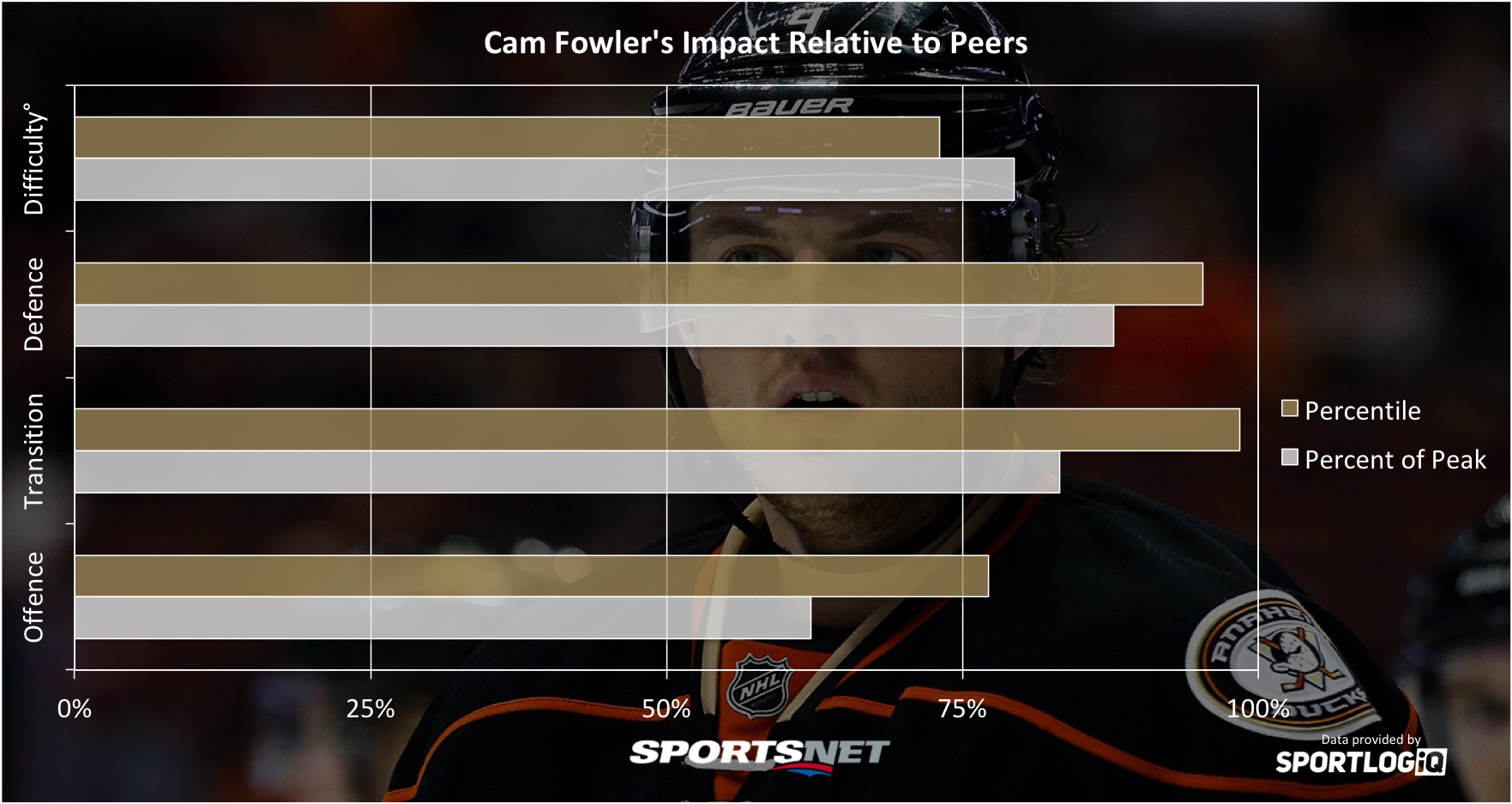
I’m always a little surprised by how well Fowler shows in these breakdowns, but he is a smooth operator. On a team with a lot of slower, physical forwards, Fowler and Lindholm are the keys to the Ducks’ transition game. While Lindholm is more of a director in the neutral zone, Fowler is a versatile puck rusher and distributor in the defensive and neutral zones who breaks down defensive schemes with his playmaking and skating.
He is among the NHL’s most impressive defencemen with the puck at both blue lines, and he rarely ever makes missteps that result in turnovers. Though Fowler is 6-foot-2, he doesn’t strike anyone as a big player, though he is excellent at winning contested puck battles. He’s no Lindholm at defending the blue line, but Fowler is above average in that department, too.
5. John Klingberg
Difficulty adjustment: +2.30%
Offence: 17.71/25 | Transition: 26.83/40 | Defence: 18.24/35
Total: 62.78/100
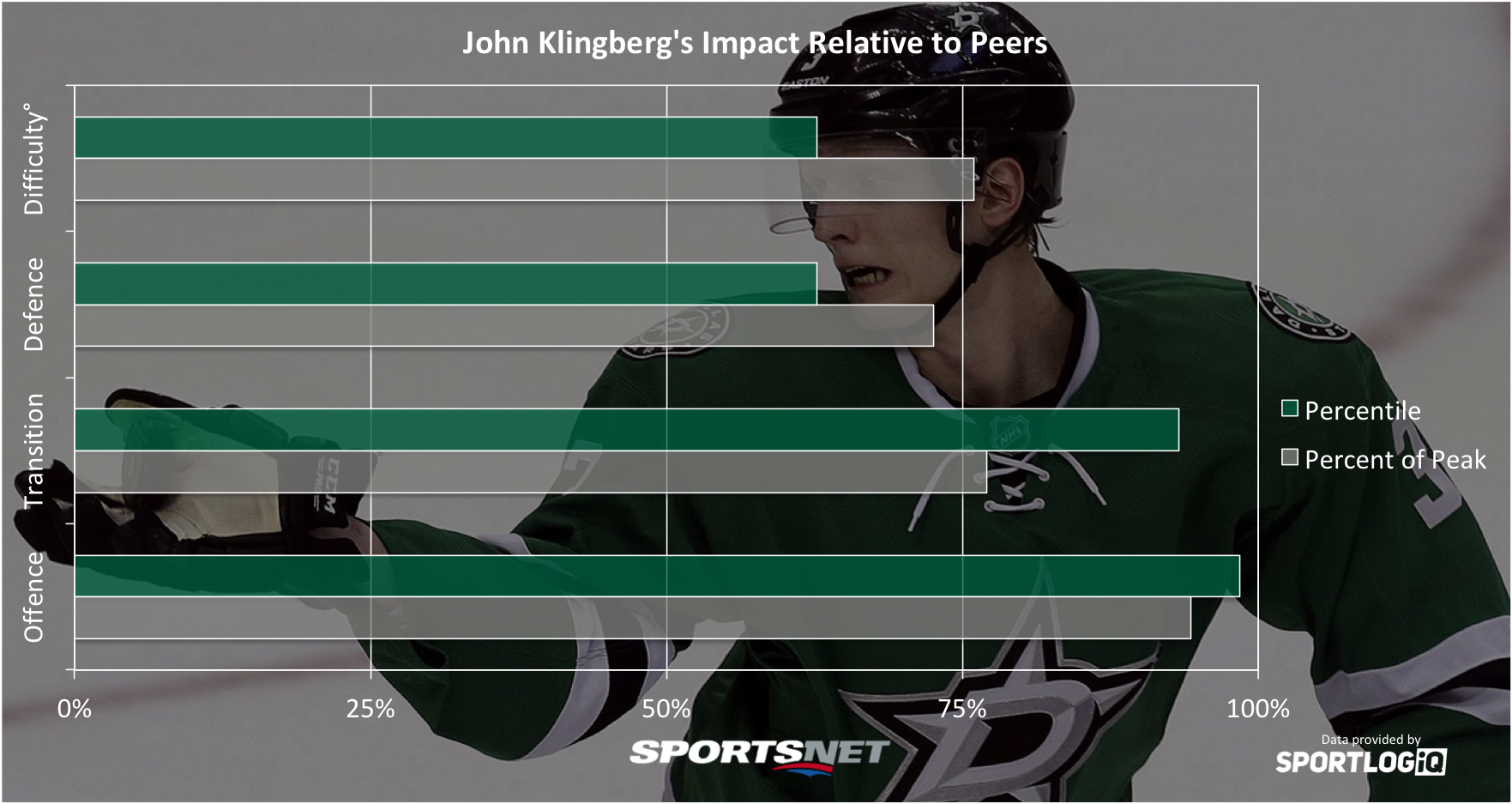
A huge jump up from 16th last year for John Klingberg thanks to a Norris nomination-worthy season in which he beautifully rounded out his game. Last season Klingberg was a controlled zone exit and entry machine, right there with Roman Josi as the best in the league, and he combined his puck rushing with an improved passing game in both the defensive and neutral zones.
Defensively, there’s still some work to be done for Klingberg, as he struggles to win puck battles, is below average at defending the blue line, and can be too hesitant in the neutral zone. But his defensive zone work is pretty strong. He has become very aggressive on loose pucks in the defensive zone which, combined with his zone exit ability, stops a lot of offence before opponents can generate it. At the same time, he’s become an excellent penalty killer.
4. Mark Giordano
Difficulty adjustment: +2.24%
Offence: 12.80/25 | Transition: 28.37/40 | Defence: 22.90/35
Total: 64.07/100
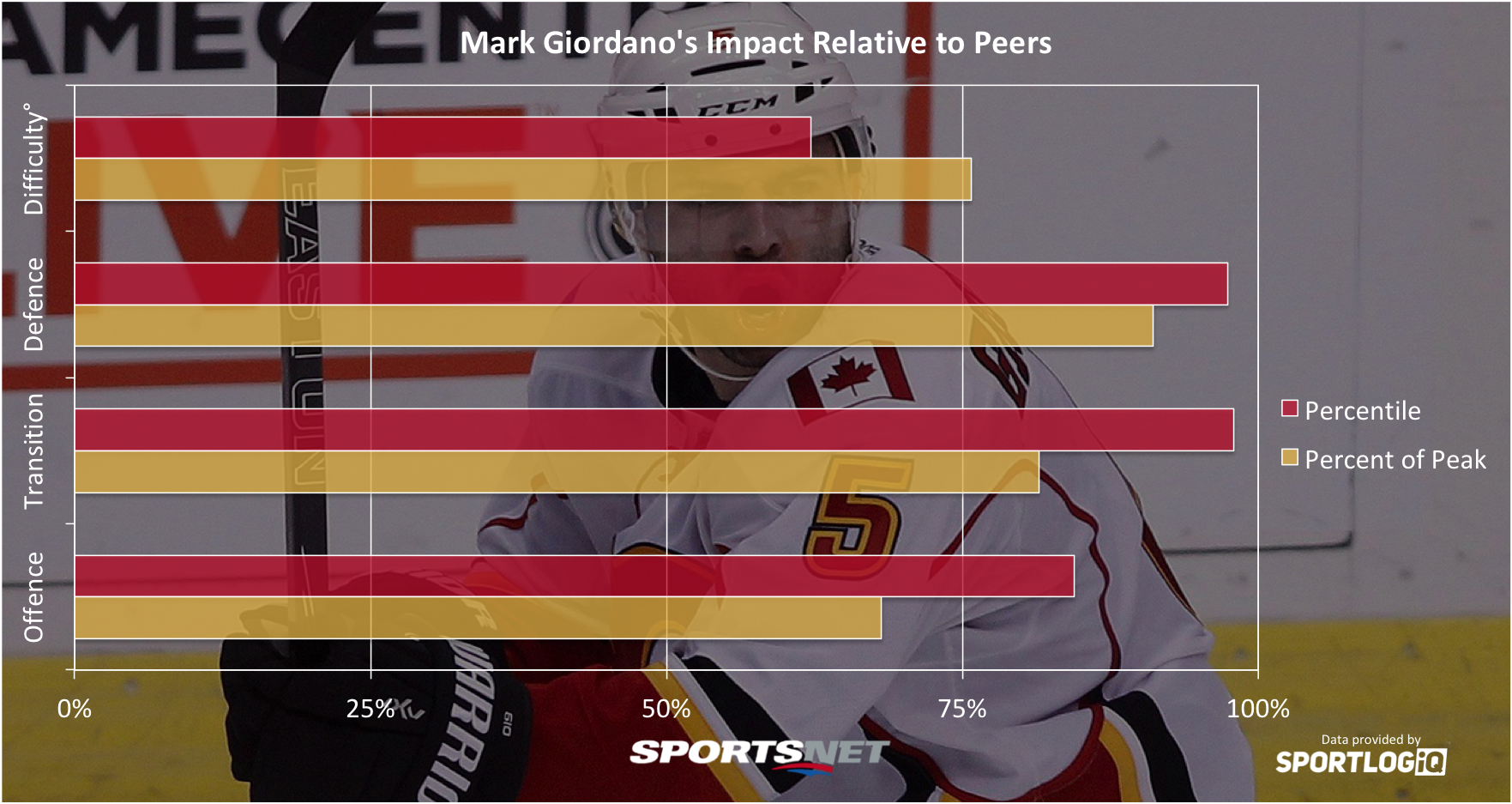
Outside of Dustin Byfuglien, only one other player manages to win more than 50 per cent of the puck battles they engage in: Mark Giordano.
Gio is an old-school hockey fan’s platonic ideal of the perfect defenceman. He plays a hard-nosed style in the modern game that sacrifices none of the quick transition and offensive skill that younger hockey fans love.
Giordano is a general from the back end, leading the league in defensive zone passes over the past three years and finishing second in pass success rate. He doesn’t carry the puck much, so he has to rely on his passing to move the puck up the ice, but he does it brilliantly. The one area where it looks like Giordano could be exploited as he gets older is defending the blue line — he’s getting beat more often now than years past.
3. P.K. Subban
Difficulty adjustment: +5.55%
Offence: 15.95/25 | Transition: 28.05/40 | Defence: 23.61/35
Total: 67.60/100
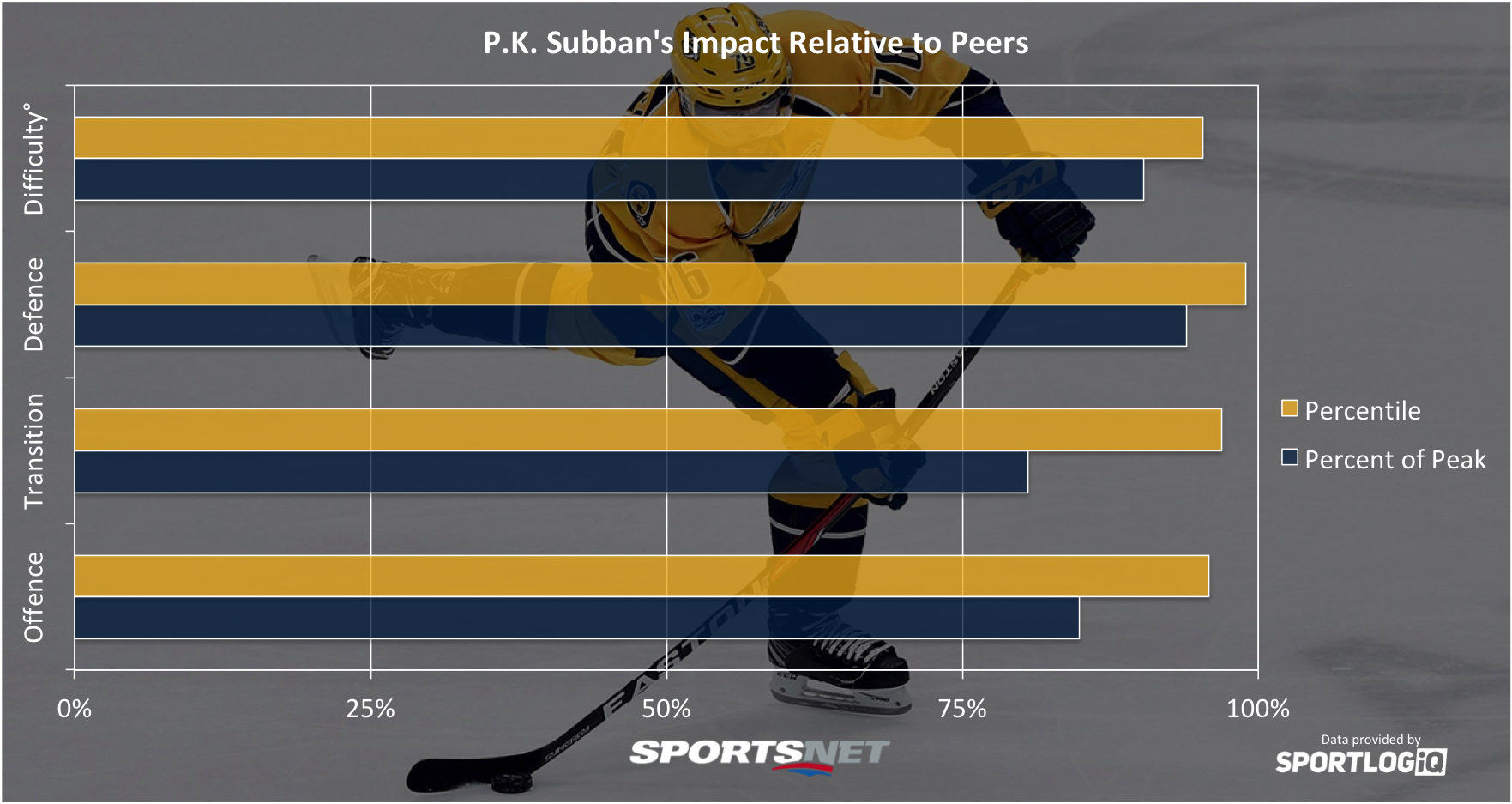
Subban drops one spot from last year after his third Norris Trophy nomination in six seasons. Carrying around Alexei Emelin most of the season was an arduous task and a big change from spending most of the previous season with Mattias Ekholm. But Subban made the most of it by leading all defencemen in primary points last year, and posting a career high in goals.
Subban is one of the best passers in the NHL, posting high volume and clinical efficiency in every zone, even though he makes far more dangerous passes than the average defenceman. With that high pass success rate comes very low turnover rates, leading to smooth transition and fewer counter attacks.
He’s also one of the game’s best defenders of the blue line; only Hampus Lindholm is victimized for fewer controlled entries. Subban’s weaknesses continue to be a penchant for penalties, and an eagerness to dump the puck out of the defensive zone too often. He is spectacular at clearing the zone with dump outs, boasting the highest success rate in the league, but his talent level is too high to do it as often as he does.
2. Drew Doughty
Difficulty adjustment: +4.72%
Offence: 12.66/25 | Transition: 34.81/40 | Defence: 22.98/35
Total: 70.45/100
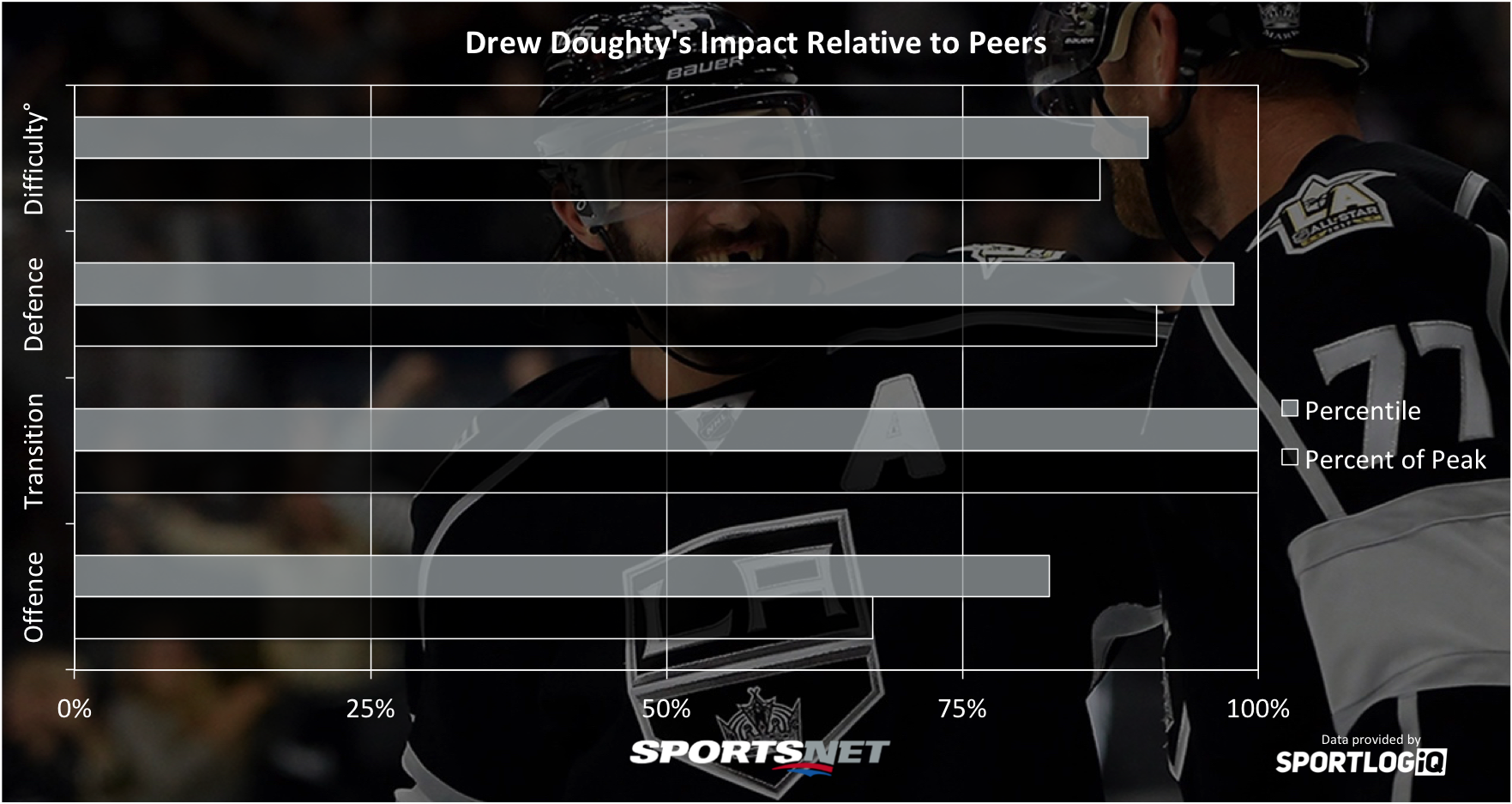
For my money, Doughty should have won the Norris last season and it shouldn’t have been close. Doughty isn’t as offensively dynamic as some of the others on this list, but he is the NHL’s king of puck movement.
For three straight seasons, Doughty has posted the best pass success rate in the league, while also making more passes per minute played than anyone else. He can skate the puck as well as anyone. Add in that he’s one of the best defenders of the blue line in the NHL, and a heck of a puck battler and penalty-killer, while rarely taking penalties himself, and you’ve got a franchise player.
1. Erik Karlsson
Difficulty adjustement: +6.81%
Offence: 17.44/25 | Transition: 30.74/40 | Defence: 25.13/35
Total: 73.31/100
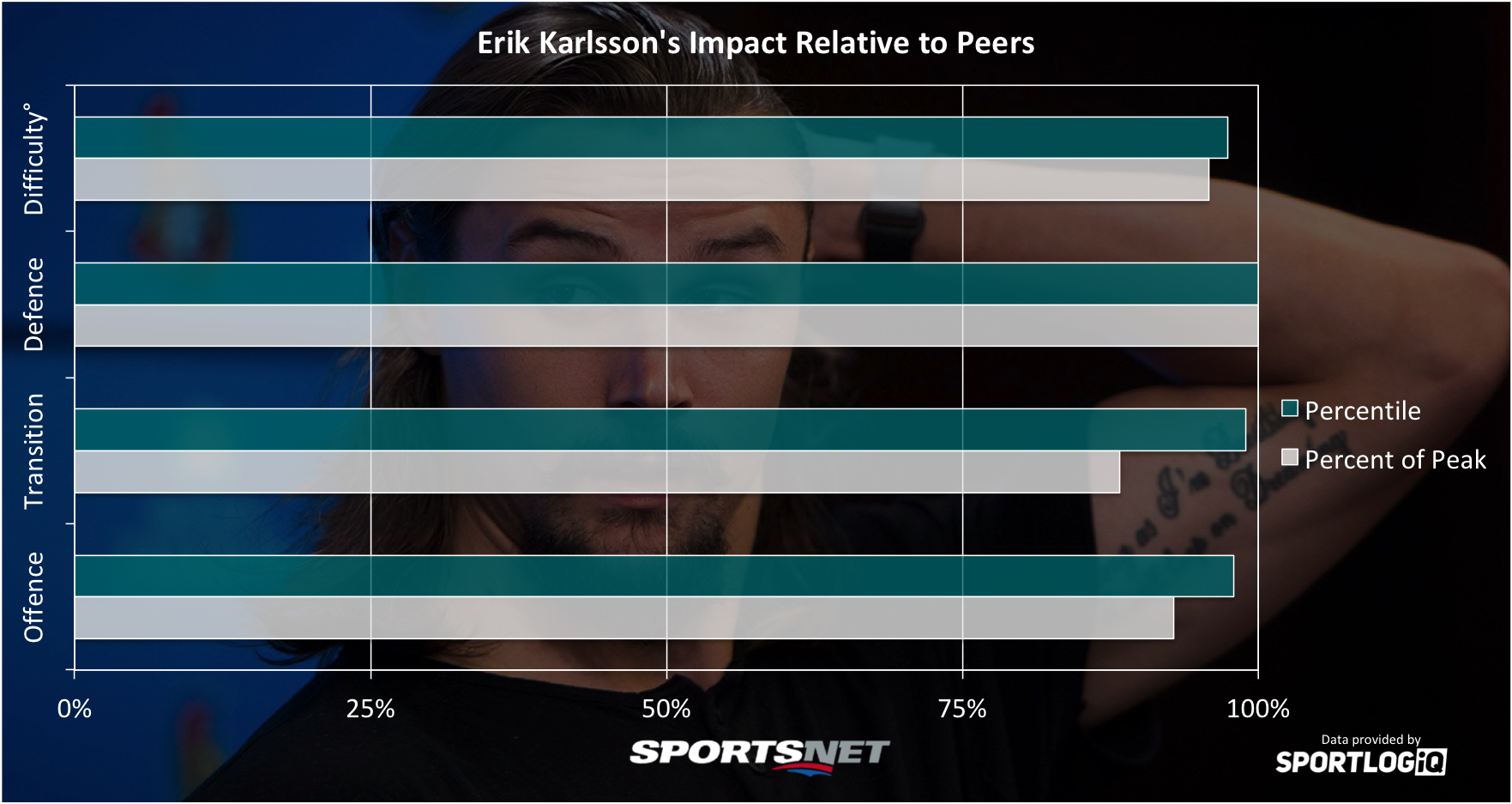
Erik Karlsson had a really bad season last year — he measured as only the second best defenceman in the league. It’s the second time in the past five years he wasn’t the best, and I’m sure he’s a little miffed about it. Despite that, he’s the only person since I’ve started these rankings who’s finished at the top of their position each time — and Karlsson’s never really been close to being unseated.
Karlsson is a wonderous offensive talent, which everyone knows. But his defence actually sticks out the most from his peers. He has one of the lowest turnover rates relative to his teammates of anyone in the league, recovers loose pucks like it’s easy to beat players to them while pivoting, is among the best in the league at denying zone entries, and has one of the best sticks in the game for blocking passing lanes. He could be a bit stronger in puck battles, but that’s a pretty slight criticism.







